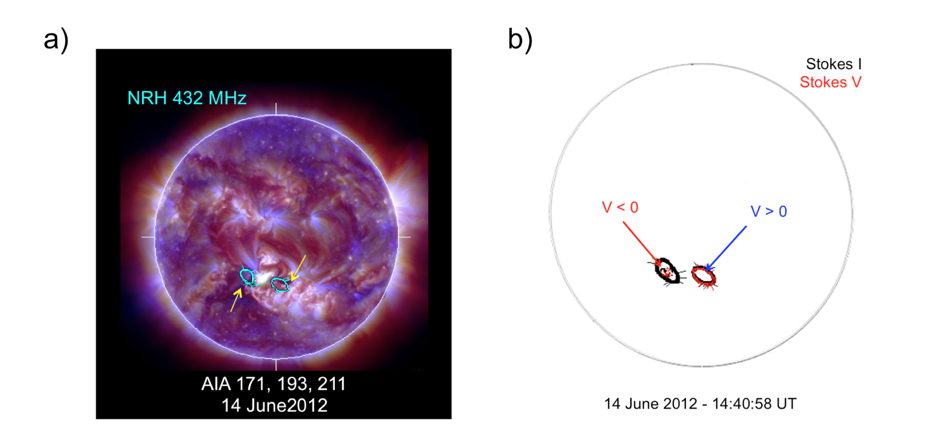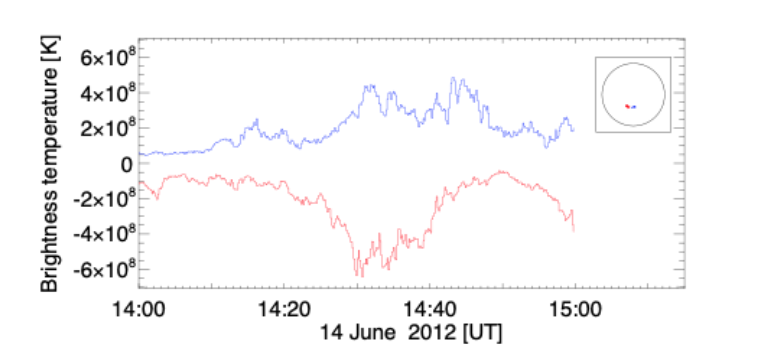A coronal mass ejection (CME) is a phenomenon which produces large-scale ejections of mass and magnetic field from the lower corona into the interplanetary space (e.g. Forbes, 2000). The ejection of CMEs is often accompanied by the radio emission from non-thermal electrons. Particularly, stationary type IV continua are thought to be emitted by electrons in closed magnetic structures in the wake of the rising CME. Although basic properties, such as the long duration (several hours), strong polarisation, and the emission process, have been well known for more than fifty years (Pick-Gutmann, 1961; Weiss, 1963; Kai et al, 1985), there have been no systematic studies since the 1980s.
The present work presents a systematic study of seven well-observed stationary type IV bursts using data of the Nançay Radioheliograph together with white-light coronagraphy, EUV imaging and magnetography from the SoHO, Proba2, SDO and STEREO spacecraft to analyse the source structure and polarisation of the stationary type IV radio sources at decimetre-to-metre wavelengths.
Results
Stationary type IV sources show columnar structures dispersed as a function of frequency and are monopolar or, in some cases, unpolarised. The observations show that sources are emitted in one leg of the erupting magnetic flux rope of the CME. We found one event which presents a persistent bipolar source located on either side of the flaring active region, projecting onto temporary dimmings in EUV images (as is shown in Figure 1). This confirms the location of the radio sources in the legs of the erupting flux rope.
 Figure 1 – a) Location of radio sources at 432 MHz during a bipolar stationary type IV burst (Stokes parameter I). The contours of equal brightness temperature at 50% of the maximum are plotted on a combination of AIA images (17.1, 19.3 and 21.1 nm). The yellow arrows indicate the location of dimmings. b) Radio sources in Stokes I (black) and V (red). b) Stokes I map at 432 MHz showing two sources with opposite senses of circular polarisation. Modified from Salas-Matamoros and Klein (2020).
Figure 1 – a) Location of radio sources at 432 MHz during a bipolar stationary type IV burst (Stokes parameter I). The contours of equal brightness temperature at 50% of the maximum are plotted on a combination of AIA images (17.1, 19.3 and 21.1 nm). The yellow arrows indicate the location of dimmings. b) Radio sources in Stokes I (black) and V (red). b) Stokes I map at 432 MHz showing two sources with opposite senses of circular polarisation. Modified from Salas-Matamoros and Klein (2020).
The unique bipolar event also allowed us to estimate the energy of the radiating electrons from the correlation of the brightness temperature profiles (Figure 2) of the two components. The profile of the western component (Stokes V>0) is delayed with respect to the eastern source (V<0) by about 36 s. Using the estimate of the flux rope geometry from EUV observations, we found energies of about 20 keV. We also showed that such energies are sufficient to enable electrons to bounce back and forth along the extended flux rope, but that Coulomb collisions would prevent electrons with lower energies (below about 15 keV in our estimate) from doing so. The upper limit of the energy could explain why most stationary type IV sources are restricted to one leg of the flux rope. A continuous acceleration of these electrons is in any case necessary to maintain the radio emission over more than a few tens of seconds.
 Figure 2 – Polarised brightness temperature profile of two stationary type IV sources. The blue and red curves refer to the source with V>0 and with V<0, respectively. Integration time 10 seconds. Modified from Salas-Matamoros and Klein (2020).
Figure 2 – Polarised brightness temperature profile of two stationary type IV sources. The blue and red curves refer to the source with V>0 and with V<0, respectively. Integration time 10 seconds. Modified from Salas-Matamoros and Klein (2020).
The comparison of radio maps in Stokes I and V with photospheric magnetograms and their extrapolation into the corona confirms the idea that the radio emission is in the ordinary mode, suggesting fundamental plasma emission. This result is consistent with previous work, but does not rely on the hitherto used hypothesis that the magnetic field polarity in the radio source is determined by the leading or dominant sunspot in the active region. This hypothesis is shown to be inconclusive in at least two of the seven events studied, where noise storms and stationary type IV continua from the same active region had opposite senses of polarisation.
The circular polarisation was in general found to increase from low to high values in the early phase of a stationary type IV continuum, but it was in general found to not be total. This is also a known result, which has generally been ascribed to depolarisation of the radio emission during propagation in the corona, for instance in the turbulent plasma around the rising CME. The fact that one of the two oppositely polarized sources in Fig. 2 is partially polarised throughout its duration, while the other is fully polarised, is inconsistent with this interpretation. The observations presented in this work show that the radio sources are not uniform, but comprise partially resolved and probably unresolved substructure with different degrees of polarisation. The temporal increase of the circular polarization goes along with the disappearance of the unpolarised sources. We propose to explain partial polarisation by the coexistence of fundamental and harmonic plasma emission in different sub- structures within the antenna beam in the early phase of a stationary type IV burst.
Conclusions
Even though stationary type IV continua are known since the 1960s, the multi-frequency and multi-instrument analysis outlined here allowed us to revisit the structure, location and polarisation of the radio sources. The comparison with magnetic field measurements in the photosphere and their extrapolation in the corona gave a clearer view of the polarisation, and the comparison with EUV and white-light imaging a clearer identification of the magnetic structure where the radio emission is generated. The observations point to acceleration processes in the wake of the rising CME, consistent with ideas that the particle acceleration accompanies the reconnection of the stressed magnetic field after the CME passage. These observations also allowed us a new estimate of the electron energy, up to several tens of keV, which is consistent with the observed mean brightness temperatures in the picture where the radio emission is produced by spontaneous plasma emission (e.g., Wentzel, 1986).
Based on the recent paper (open access): Salas-Matamoros,C and Klein, K-L: https://ui.adsabs.harvard.edu/abs/2020A%26A…639A.102S/abstract
References
Pick-Gutmann, M. 1961, Annales dick-Gutmann, M, 24, 181.
